lights SKODA FABIA 2006 2.G / 5J Repair Manual
[x] Cancel search | Manufacturer: SKODA, Model Year: 2006, Model line: FABIA, Model: SKODA FABIA 2006 2.G / 5JPages: 258, PDF Size: 44.86 MB
Page 173 of 258
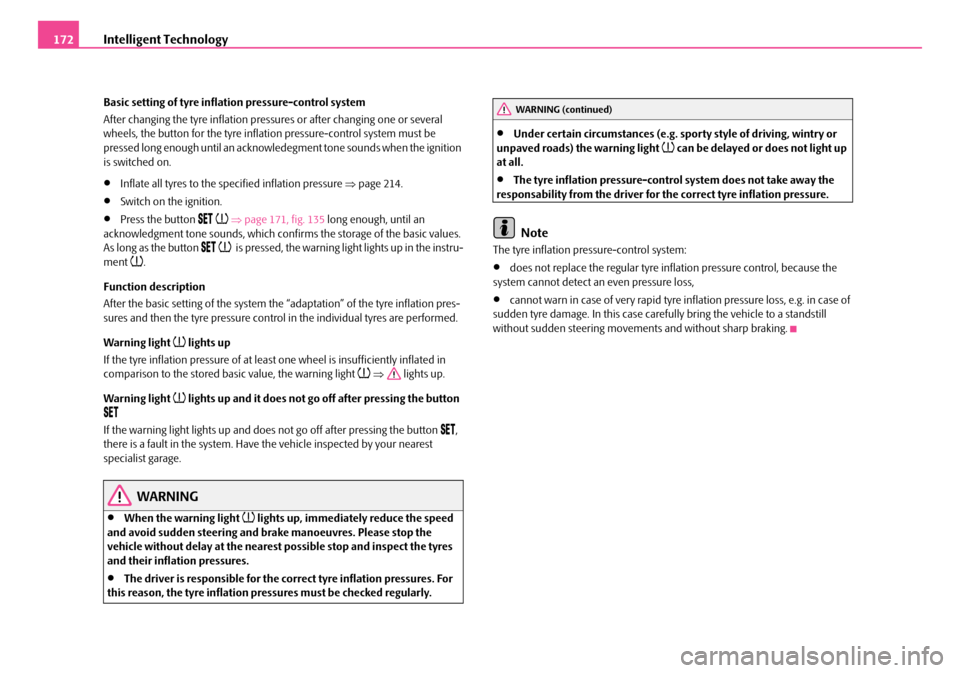
Intelligent Technology172
Basic setting of tyre inflation pressure-control system
After changing the tyre inflation pressures or after changing one or several wheels, the button for the tyre inflation pressure-control system must be pressed long enough until an acknowle degment tone sounds when the ignition is switched on.
•Inflate all tyres to the specified inflation pressure ⇒page 214.
•Switch on the ignition.
•Press the button ⇒page 171, fig. 135 long enough, until an acknowledgment tone sounds, which conf irms the storage of the basic values. As long as the button is pressed, the warning li ght lights up in the instru- ment .
Function description
After the basic setting of the system the “adaptation” of the tyre inflation pres- sures and then the tyre pressure control in the individual tyres are performed.
Warning light lights up
If the tyre inflation pressure of at least one wheel is insufficiently inflated in comparison to the stored ba sic value, the warning light ⇒ lights up.
Warning light lights up and it does not go off after pressing the button
If the warning light lights up and do es not go off after pressing the button , there is a fault in the system. Have the vehicle inspected by your nearest specialist garage.
WARNING
•When the warning light lights up, immediately reduce the speed and avoid sudden steering and brak e manoeuvres. Please stop the vehicle without delay at the nearest possible stop and inspect the tyres and their inflation pressures.
•The driver is responsible for the co rrect tyre inflation pressures. For this reason, the tyre inflation pr essures must be checked regularly.
•Under certain circumstances (e.g. sporty style of driving, wintry or unpaved roads) the warning light can be delayed or does not light up at all.
•The tyre inflation pressure-control system does not take away the responsability from the driver for the correct tyre inflation pressure.
Note
The tyre inflation pressure-control system:
•does not replace the regular tyre inflation pressure control, because the system cannot detect an even pressure loss,
•cannot warn in case of very rapid tyre in flation pressure loss, e.g. in case of sudden tyre damage. In this case carefully bring the vehicle to a standstill without sudden steering movements and without sharp braking.
WARNING (continued)
NKO A05Fabia 20.book Page 172 Tuesday, September 26, 2006 8:38 AM
Page 176 of 258

Driving and the Environment175
Using the systemSafetyDriving TipsGeneral MaintenanceBreakdown assistanceTechnical Data
Driving in an economical and
environmentally conscious manner
General
Your personal style of driving is a major factor.
Your fuel consumption, any pollution of the environmental and the wear-and- tear to the engine, brakes and tyres, depend essentially on three factors:
•your personal style of driving,
•the conditions under which your vehicle is operated,
•technical aspects.
You can easily improve your fuel economy by 10 - 15 percent by driving in an economical way with foresight. This sect ion is intended to provide you with a number of tips on how to protect the en vironment and at the same time save money.
The fuel consumption can naturally also be influenced by factors which are beyond the driver's control. It is, for example, normal for the fuel consumption to increase in winter and under worsened conditions such as poor road condi- tions, towing a trailer, etc.
The technical requirements for low fuel usage and economic efficiency of the vehicle have already been built into the vehicle at the works. Special attention has been given to minimising negative effects on the environment. It is neces- sary to take note of the guidelines given in this chapter in order to make best use of these characteristics and to maintain their effectiveness.
Looking ahead when driving
A vehicle's highest fuel consumption occurs it accelerates.
Avoid accelerating and braking unnecessarily. If you drive with forsight you will not need to brake so often and will also then not have to accelerate so much. Let your vehicle coast to a stop, for exam ple, if this is possible, when you see that the next set of traffic lights is at red.
Shifting gears and saving energy
Shifting up early saves on fuel.
Manual gearbox
– Drive no more than about one length of your vehicle in first gear.
Always shift up into the next high er gear at approx. 2 000 to 2 500
revs.
Fig. 136 Fuel consump- tion in litres/100 km. and speed in km/h.
NKO A05Fabia 20.book Page 175 Tuesday, September 26, 2006 8:38 AM
Page 178 of 258
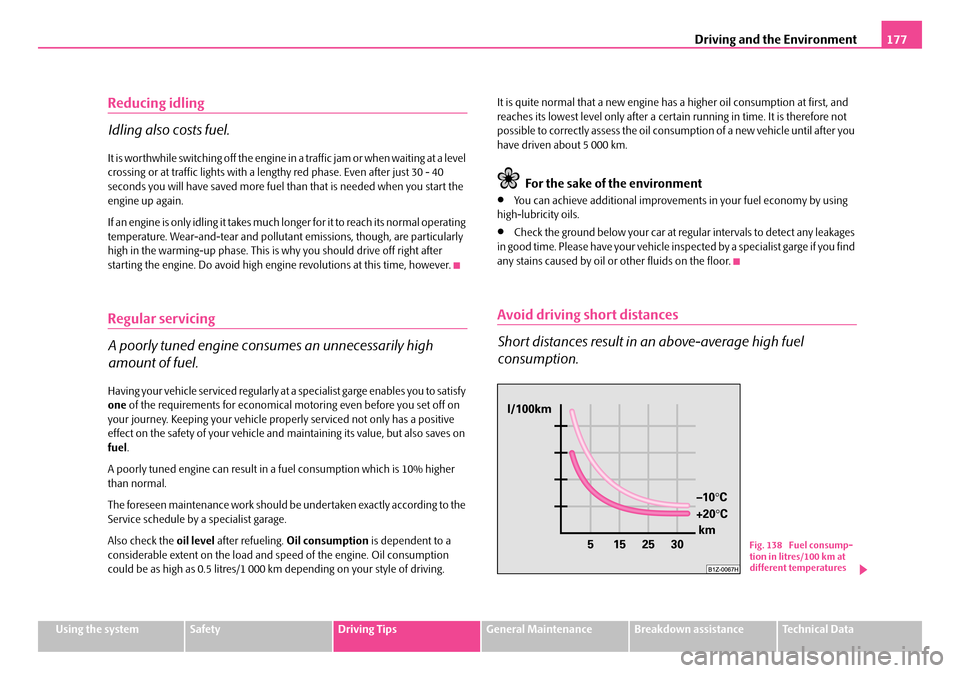
Driving and the Environment177
Using the systemSafetyDriving TipsGeneral MaintenanceBreakdown assistanceTechnical Data
Reducing idling
Idling also costs fuel.
It is worthwhile switching off the engine in a traffic jam or when waiting at a level crossing or at traffic lights with a le ngthy red phase. Even after just 30 - 40 seconds you will have saved more fuel th an that is needed when you start the engine up again.
If an engine is only idling it takes much longer for it to reach its normal operating temperature. Wear-and-tear and pollutant emissions, though, are particularly high in the warming-up phase. This is why you should drive off right after starting the engine. Do avoid high engi ne revolutions at this time, however.
Regular servicing
A poorly tuned engine consum es an unnecessarily high
amount of fuel.
Having your vehicle serviced regularly at a specialist garge enables you to satisfy one of the requirements for economical motoring even before you set off on your journey. Keeping your vehicle prop erly serviced not only has a positive effect on the safety of your vehicle and maintaining its value, but also saves on fuel .
A poorly tuned engine can result in a fuel consumption which is 10% higher than normal.
The foreseen maintenance work should be undertaken exactly according to the Service schedule by a specialist garage.
Also check the oil level after refueling. Oil consumption is dependent to a considerable extent on the load and speed of the engine. Oil consumption could be as high as 0.5 litres/1 000 km depending on your style of driving.
It is quite normal that a new engine ha s a higher oil consumption at first, and reaches its lowest level only after a certain running in time. It is therefore not possible to correctly assess the oil cons umption of a new vehicle until after you have driven about 5 000 km.
For the sake of the environment
•You can achieve addi tional improvements in your fuel economy by using high-lubricity oils.
•Check the ground below your car at regular intervals to detect any leakages in good time. Please have your vehicle inspected by a specialist garge if you find any stains caused by oil or other fluids on the floor.
Avoid driving short distances
Short distances result in an above-average high fuel
consumption.
Fig. 138 Fuel consump- tion in litres/100 km at different temperatures
NKO A05Fabia 20.book Page 177 Tuesday, September 26, 2006 8:38 AM
Page 181 of 258
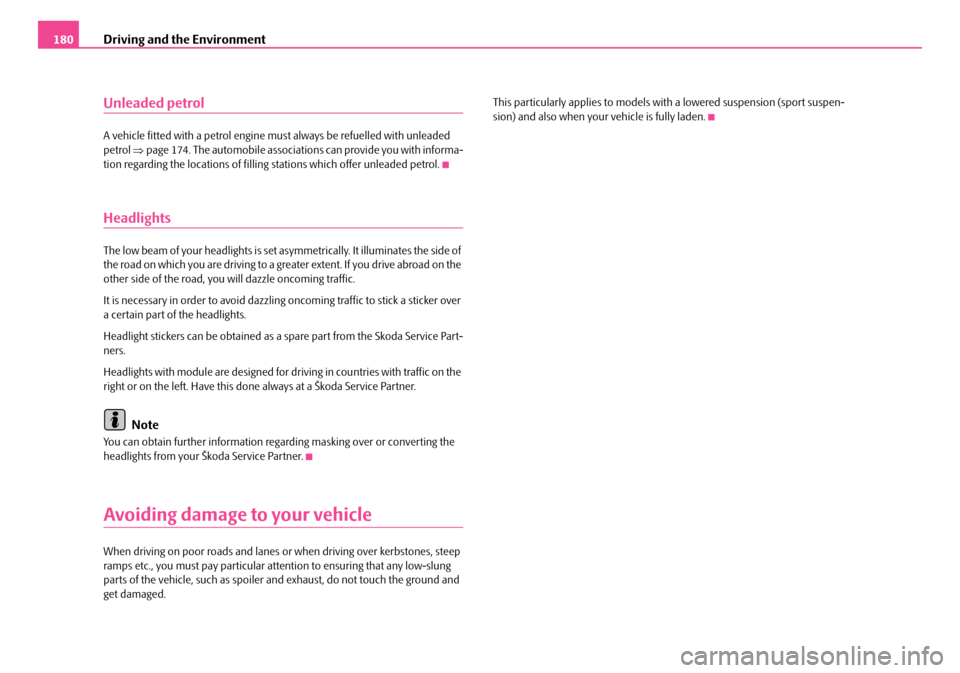
Driving and the Environment180
Unleaded petrol
A vehicle fitted with a petrol engine must always be refuelled with unleaded petrol ⇒page 174. The automobile associations can provide you with informa- tion regarding the locations of fillin g stations which offer unleaded petrol.
Headlights
The low beam of your headlights is set asymmetrically. It illuminates the side of the road on which you are driving to a gr eater extent. If you drive abroad on the other side of the road, you will dazzle oncoming traffic.
It is necessary in order to avoid dazzling oncoming traffic to stick a sticker over a certain part of the headlights.
Headlight stickers can be obtained as a spare part from the Skoda Service Part- ners.
Headlights with module are designed for dr iving in countries with traffic on the right or on the left. Have this done always at a Škoda Service Partner.
Note
You can obtain further information rega rding masking over or converting the headlights from your Škoda Service Partner.
Avoiding damage to your vehicle
When driving on poor roads and lanes or when driving over kerbstones, steep ramps etc., you must pay particular atte ntion to ensuring that any low-slung parts of the vehicle, such as spoiler an d exhaust, do not touch the ground and get damaged.
This particularly applies to models with a lowered suspension (sport suspen- sion) and also when your vehicle is fully laden.
NKO A05Fabia 20.book Page 180 Tuesday, September 26, 2006 8:38 AM
Page 183 of 258
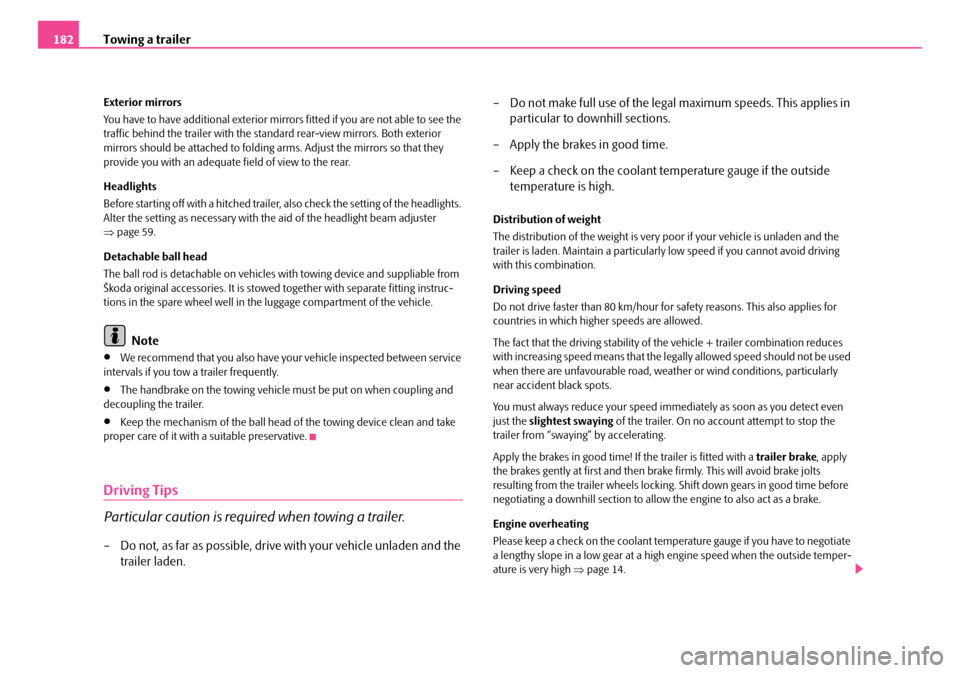
Towing a trailer182
Exterior mirrors
You have to have addi tional exterior mirrors fitted if you are not able to see the traffic behind the trailer with the standard rear-view mirrors. Both exterior mirrors should be attached to folding arms. Adjust the mirrors so that they provide you with an adequate field of view to the rear.
Headlights
Before starting off with a hitched trailer, also check the setting of the headlights. Alter the setting as necessary with th e aid of the headlight beam adjuster ⇒ page 59.
Detachable ball head
The ball rod is detachable on vehicles with towing device and suppliable from Škoda original accessories. It is stowed together with separate fitting instruc- tions in the spare wheel well in the luggage compartment of the vehicle.
Note
•We recommend that you also have yo ur vehicle inspected between service intervals if you tow a trailer frequently.
•The handbrake on the towing vehicle must be put on when coupling and decoupling the trailer.
•Keep the mechanism of the ball head of the towing device clean and take proper care of it with a suitable preservative.
Driving Tips
Particular caution is required when towing a trailer.
– Do not, as far as possible, drive with your vehicle unladen and the
trailer laden.
– Do not make full use of the lega l maximum speeds. This applies in
particular to downhill sections.
– Apply the brakes in good time.
– Keep a check on the coolant temperature gauge if the outside
temperature is high.
Distribution of weight
The distribution of the weight is very poor if your vehicle is unladen and the trailer is laden. Maintain a particularly low speed if you cannot avoid driving with this combination.
Driving speed
Do not drive faster than 80 km/hour for safety reasons. This also applies for countries in which higher speeds are allowed.
The fact that the driving stability of the vehicle + trailer combination reduces with increasing speed means that the legally allowed speed should not be used when there are unfavourable road, weat her or wind conditions, particularly near accident black spots.
You must always reduce your speed imme diately as soon as you detect even just the slightest swaying of the trailer. On no account attempt to stop the trailer from “swaying ” by accelerating.
Apply the brakes in good time! If the trailer is fitted with a trailer brake, apply the brakes gently at first and then brake firmly. This will avoid brake jolts resulting from the trailer wheels locking. Shift down gears in good time before negotiating a downhill section to allow the engine to also act as a brake.
Engine overheating
Please keep a check on the coolant temperature gauge if you have to negotiate a lengthy slope in a low gear at a high engine speed when the outside temper- ature is very high ⇒page 14.
NKO A05Fabia 20.book Page 182 Tuesday, September 26, 2006 8:38 AM
Page 190 of 258
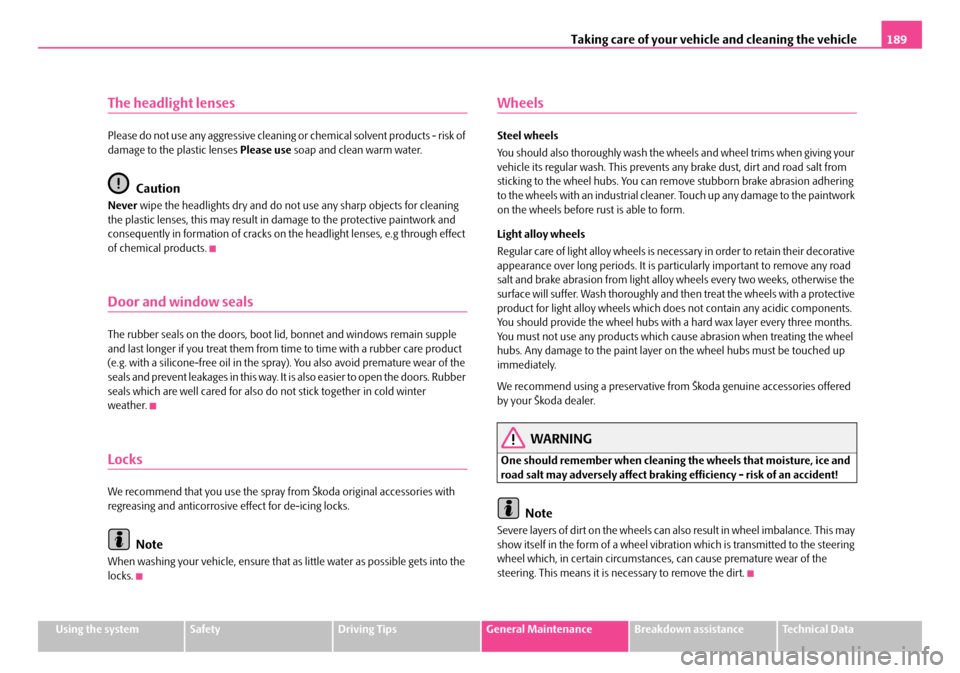
Taking care of your vehicle and cleaning the vehicle189
Using the systemSafetyDriving TipsGeneral MaintenanceBreakdown assistanceTechnical Data
The headlight lenses
Please do not use any aggressive cleaning or chemical solvent products - risk of damage to the plastic lenses Please use soap and clean warm water.
Caution
Never wipe the headlights dry and do not use any sharp objects for cleaning the plastic lenses, this may result in da mage to the protective paintwork and consequently in formation of cracks on the headlight lenses, e.g through effect of chemical products.
Door and window seals
The rubber seals on the doors, boot lid, bonnet and windows remain supple and last longer if you trea t them from time to time with a rubber care product (e.g. with a silicone-free oil in the spray). You also avoid premature wear of the seals and prevent leakages in this way. It is also easier to open the doors. Rubber seals which are well cared for also do not stick together in cold winter weather.
Locks
We recommend that you use the spray fr om Škoda original accessories with regreasing and anticorrosive effect for de-icing locks.
Note
When washing your vehicle, ensure that as little water as possible gets into the locks.
Wheels
Steel wheels
You should also thoroughly wash the wheels and wheel trims when giving your vehicle its regular wash. This prevents an y brake dust, dirt and road salt from sticking to the wheel hubs. You can remo ve stubborn brake abrasion adhering to the wheels with an industrial cleane r. Touch up any damage to the paintwork on the wheels before rust is able to form.
Light alloy wheels
Regular care of light alloy wheels is necessary in order to retain their decorative appearance over long periods. It is particularly important to remove any road salt and brake abrasion from light alloy wheels every two weeks, otherwise the surface will suffer. Wash thoroughly and th en treat the wheels with a protective product for light alloy wheels which does not contain any acidic components. You should provide the wheel hubs with a hard wax layer every three months. You must not use any products which ca use abrasion when treating the wheel hubs. Any damage to the paint layer on the wheel hubs must be touched up immediately.
We recommend using a preservative fr om Škoda genuine accessories offered by your Škoda dealer.
WARNING
One should remember when cleaning the wheels that moisture, ice and road salt may adversely affect brakin g efficiency - risk of an accident!
Note
Severe layers of dirt on the wheels can also result in wheel imbalance. This may show itself in the form of a wheel vibrat ion which is transmitted to the steering wheel which, in certain circumstance s, can cause premature wear of the steering. This means it is necessary to remove the dirt.
NKO A05Fabia 20.book Page 189 Tuesday, September 26, 2006 8:38 AM
Page 212 of 258
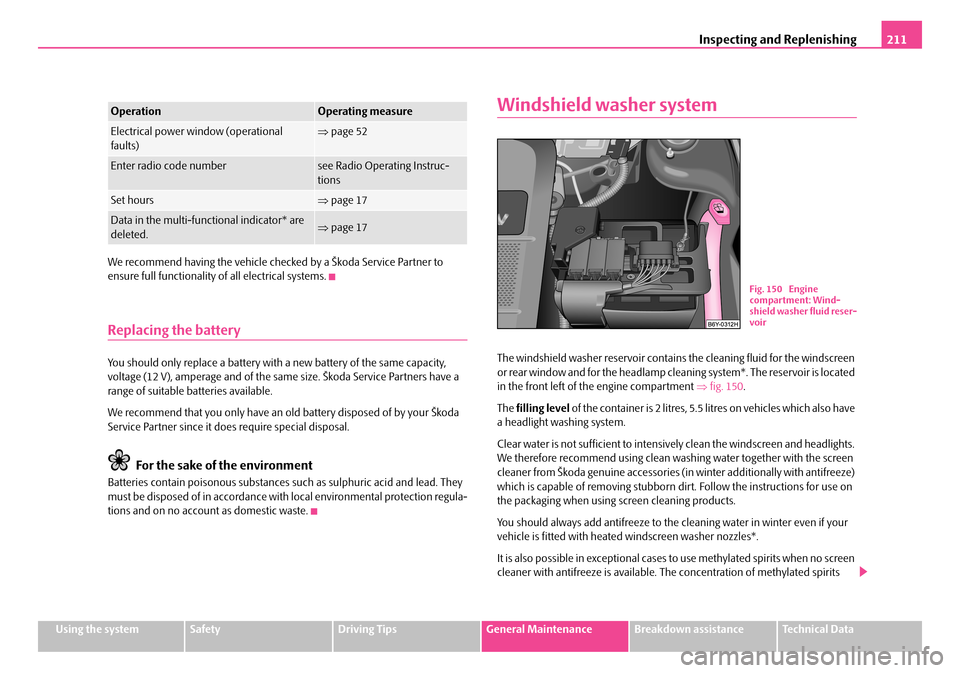
Inspecting and Replenishing211
Using the systemSafetyDriving TipsGeneral MaintenanceBreakdown assistanceTechnical Data
We recommend having the vehicle checked by a Škoda Service Partner to ensure full functionality of all electrical systems.
Replacing the battery
You should only replace a battery with a new battery of the same capacity, voltage (12 V), amperage and of the same size. Škoda Service Partners have a range of suitable batteries available.
We recommend that you only have an ol d battery disposed of by your Škoda Service Partner since it does require special disposal.
For the sake of the environment
Batteries contain poisonous substances su ch as sulphuric acid and lead. They must be disposed of in accordance with local environmental protection regula- tions and on no account as domestic waste.
Windshield washer system
The windshield washer reservoir contains the cleaning fluid for the windscreen or rear window and for the headlamp clea ning system*. The reservoir is located in the front left of the engine compartment ⇒fig. 150.
The filling level of the container is 2 litres, 5.5 litres on vehicles which also have a headlight washing system.
Clear water is not sufficient to intensiv ely clean the windscreen and headlights. We therefore recommend using clean washing water together with the screen cleaner from Škoda genuine accessories (i n winter additionally with antifreeze) which is capable of removing stubborn dirt. Follow the instructions for use on the packaging when using screen cleaning products.
You should always add antifreeze to the cleaning water in winter even if your vehicle is fitted with heated windscreen washer nozzles*.
It is also possible in exceptional cases to use methylated spirits when no screen cleaner with antifreeze is available. The concentration of methylated spirits
OperationOperating measure
Electrical power window (operational faults)⇒ page 52
Enter radio code numbersee Radio Operating Instruc- tions
Set hours⇒ page 17
Data in the multi-functional indicator* are deleted.⇒ page 17
Fig. 150 Engine compartment: Wind-shield washer fluid reser-voir
NKO A05Fabia 20.book Page 211 Tuesday, September 26, 2006 8:38 AM
Page 213 of 258
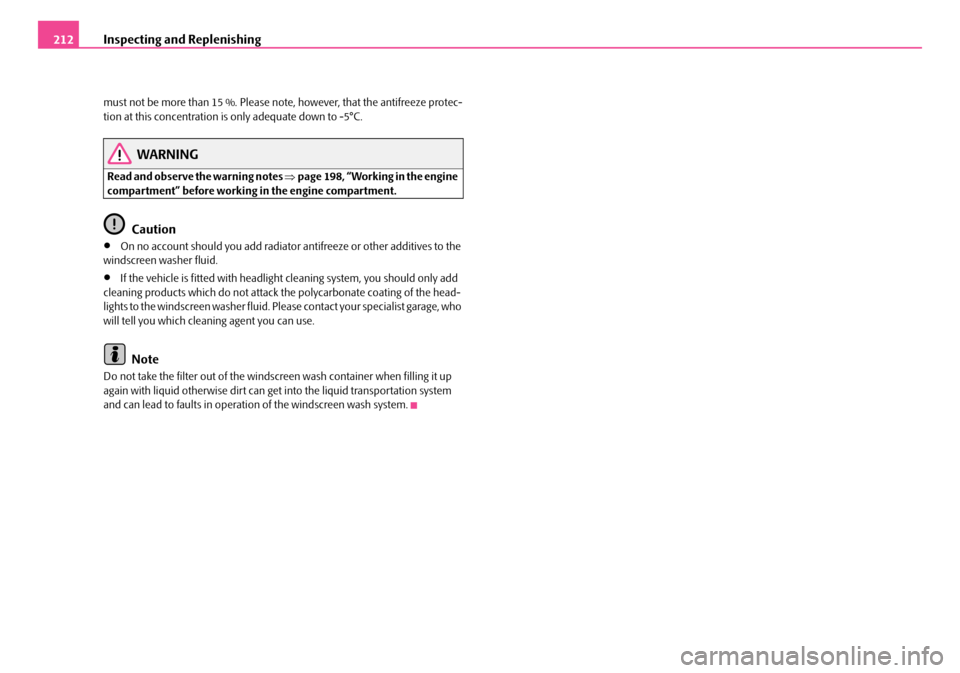
Inspecting and Replenishing212
must not be more than 15 %. Please note, however, that the antifreeze protec- tion at this concentration is only adequate down to -5°C.
WARNING
Read and observe the warning notes ⇒page 198, “Working in the engine compartment” before working in the engine compartment.
Caution
•On no account should you add radiator antifreeze or other additives to the windscreen washer fluid.
•If the vehicle is fitted with headlight cleaning system, you should only add cleaning products which do not attack the polycarbonate coating of the head- lights to the windscreen washer fluid. Please contact your specialist garage, who will tell you which clea ning agent you can use.
Note
Do not take the filter out of the windscreen wash container when filling it up again with liquid otherwise dirt can get into the liquid transportation system and can lead to faults in operation of the windscreen wash system.
NKO A05Fabia 20.book Page 212 Tuesday, September 26, 2006 8:38 AM
Page 225 of 258
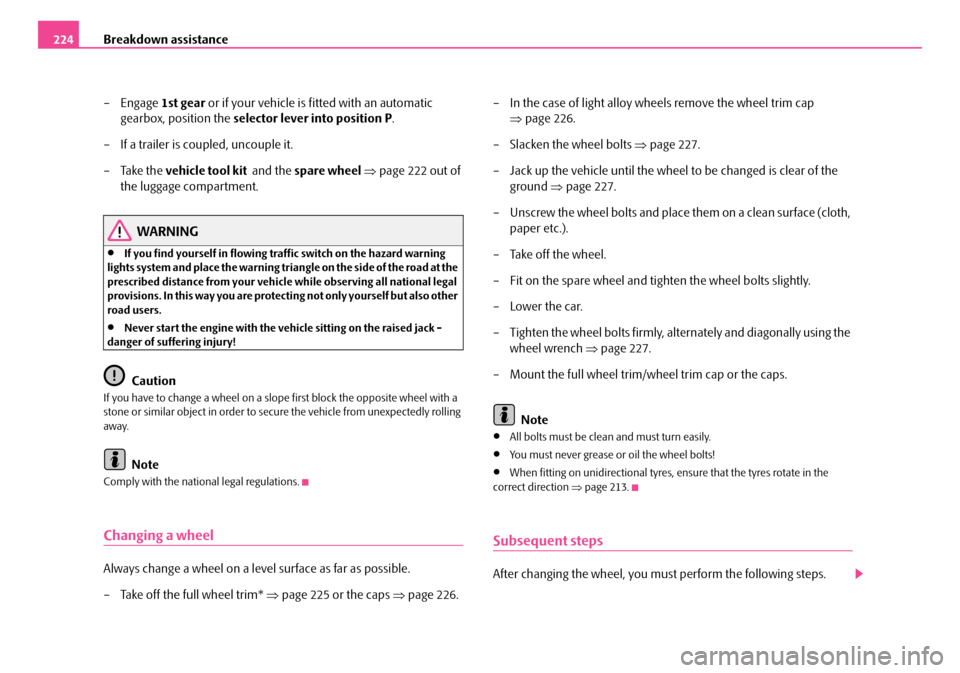
Breakdown assistance224
–Engage 1st gear or if your vehicle is fitted with an automatic
gearbox, position the selector lever into position P.
– If a trailer is coupled, uncouple it.
– Take the vehicle tool kit and the spare wheel ⇒page 222 out of
the luggage compartment.
WARNING
•If you find yourself in flowing traffic switch on the hazard warning lights system and place the warning tria ngle on the side of the road at the prescribed distance from your vehicl e while observing all national legal provisions. In this way you are protecting not only yourself but also other road users.
•Never start the engine with the vehi cle sitting on the raised jack - danger of suffering injury!
Caution
If you have to change a wheel on a slope first block the opposite wheel with a stone or similar object in order to secure the vehicle from unexpectedly rolling away.
Note
Comply with the national legal regulations.
Changing a wheel
Always change a wheel on a level surface as far as possible.
– Take off the full wheel trim* ⇒page 225 or the caps ⇒page 226.
– In the case of light alloy wheels remove the wheel trim cap
⇒ page 226.
– Slacken the wheel bolts ⇒page 227.
– Jack up the vehicle until the wheel to be changed is clear of the
ground ⇒page 227.
– Unscrew the wheel bolts and place them on a clean surface (cloth,
paper etc.).
– Take off the wheel.
– Fit on the spare wheel and tighten the wheel bolts slightly.
– Lower the car.
– Tighten the wheel bolts firmly, alternately and diagonally using the
wheel wrench ⇒page 227.
– Mount the full wheel trim/wh eel trim cap or the caps.
Note
•All bolts must be clean and must turn easily.
•You must never grease or oil the wheel bolts!
•When fitting on unidirectional tyres, ensure that the tyres rotate in the correct direction ⇒page 213.
Subsequent steps
After changing the wheel, you must perform the following steps.
NKO A05Fabia 20.book Page 224 Tuesday, September 26, 2006 8:38 AM
Page 232 of 258
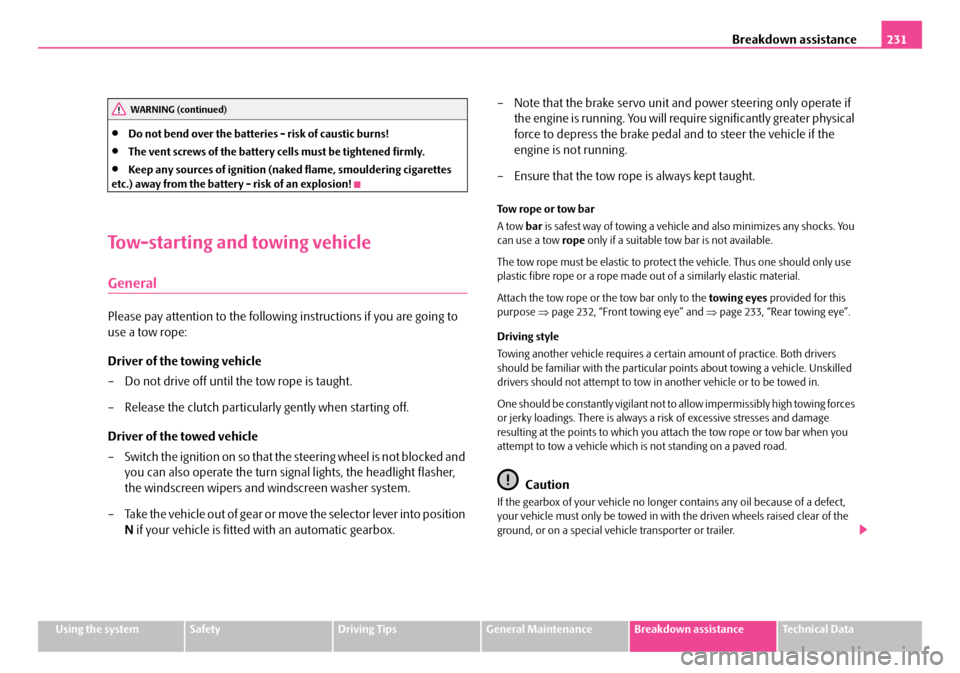
Breakdown assistance231
Using the systemSafetyDriving TipsGeneral MaintenanceBreakdown assistanceTechnical Data
•Do not bend over the batteries - risk of caustic burns!
•The vent screws of the battery cells must be tightened firmly.
•Keep any sources of ignition (naked flame, smouldering cigarettes etc.) away from the battery - risk of an explosion!
Tow-starting and towing vehicle
General
Please pay attention to the following instructions if you are going to
use a tow rope:
Driver of the towing vehicle
– Do not drive off until the tow rope is taught.
– Release the clutch particularly gently when starting off.
Driver of the towed vehicle
– Switch the ignition on so that th e steering wheel is not blocked and
you can also operate the turn signal lights, the headlight flasher,
the windscreen wipers and windscreen washer system.
– Take the vehicle out of gear or move the selector lever into position
N if your vehicle is fitted with an automatic gearbox.
– Note that the brake servo unit and power steering only operate if
the engine is running. You will requ ire significantly greater physical
force to depress the brake pedal and to steer the vehicle if the
engine is not running.
– Ensure that the tow rope is always kept taught.
Tow rope or tow bar
A tow bar is safest way of towing a vehicle and also minimizes any shocks. You can use a tow rope only if a suitable tow bar is not available.
The tow rope must be elastic to protect the vehicle. Thus one should only use plastic fibre rope or a rope made out of a similarly elastic material.
Attach the tow rope or the tow bar only to the towing eyes provided for this purpose ⇒page 232, “Front towing eye” and ⇒page 233, “Rear towing eye”.
Driving style
Towing another vehicle requires a cert ain amount of practice. Both drivers should be familiar with the particular points about towing a vehicle. Unskilled drivers should not attempt to tow in another vehicle or to be towed in.
One should be constantly vigilant not to allow impermissibly high towing forces or jerky loadings. There is always a risk of excessive stresses and damage resulting at the points to which you a ttach the tow rope or tow bar when you attempt to tow a vehicle which is not standing on a paved road.
Caution
If the gearbox of yo ur vehicle no longer contains any oil because of a defect, your vehicle must only be towed in with the driven wheels raised clear of the ground, or on a special vehicle transporter or trailer.
WARNING (continued)
NKO A05Fabia 20.book Page 231 Tuesday, September 26, 2006 8:38 AM